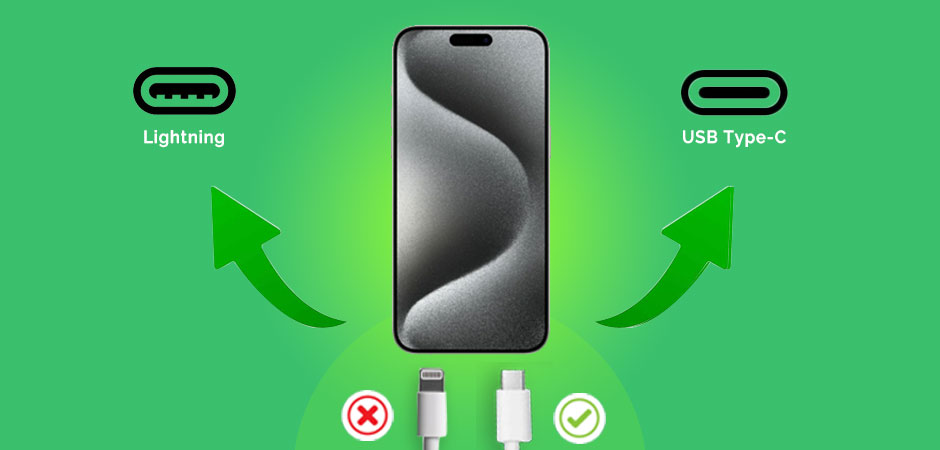Apple Finally Moving Away from Lightning and into USB-C, but why?

In the smartphone technology world, Apple has consistently pushed the limits to another level since the introduction of its most memorable iPhone in 2007. With huge advancements in equipment and programming, there have likewise been many changes in the actual ports of the iPhone. One such rumored shake-up is that Apple is switching its signature Lightning port for the widely used USB-C which left many users questioning why did Apple switch to USB-C. Apple has a history of prioritizing user experience with their connector choices. The switch from the bulky 30-pin dock connector to the sleeker Lightning port was another move in that direction, making charging and connecting devices much easier. So what is the logic behind Apple taking such a big step? To get answers to all your queries you need to read this article till the end. I have explained the possible reasons for Apple changing the iPhone port again. So get started reading! What is USB-C and Why is it Gaining Popularity? In recent years, USB-C also called USB type C has gained so much popularity as the go-to connector. It is considered the new hotness. A small plug that can connect in any way you stick it in. In addition, it can provide fast charging, and unlike older plugs, it can connect your device easily to other devices like TVs, computers, etc. Unlike the Lightning port, which works just with Apple gadgets, USB-C is a widespread interpreter for every one of your devices. It’s a similar fitting you can use for everything, from phones and PCs to cameras and, surprisingly, a game control center. No more carrying around with different cables for each thing. Due to its convenience and flexibility, it is the go-to choice for many users and manufacturers worldwide. Why does Apple use Lightning Not USB-C? Back in 2012, the Lightning port was presented by Apple and it was a critical jump forward from the old 30-pin dock connector. Here are the improvements that became the basis for this transformation: Smaller and Sleeker: The Lightning port is way more compact, making phones thinner and much lighter to hold. No more Fumbling: Unlike the older connector which fits in only one way, the Lightning port plugs in easily no matter which side is up. More Durable: Apple claims that the design of the Lightning port is long-lasting and less likely to break compared to the older connector. Since USB-C wasn’t yet introduced in the market, by creating a port, Apple had more control over the design, functionality, and potentially even the manufacturing process. This could have allowed for tighter integration with their devices. Moreover, since the Lightning port is unique to Apple devices, they could hold a strong position in what accessories were made for them. And with this control, Apple could design to work seamlessly only with their devices. This means fast charging and data transfer can work reliably across iPhones, iPads, and other Apple products. The Limitations of the Lightning Port Lightning cable compared to the 30-dock connector is a big improvement for Apple but with potential drawbacks. Let’s explore some of the limitations that lead to why Apple is changing the iPhone to USB-C. Proprietary As mentioned earlier, the Lightning port unlike the USB-C cable is limited to work only with Apple products. This means you must have separate cables for Apple devices and other electronics. One of the major issues with the previous port was the lack of versatility, which ultimately led to the question, why did Apple switch to USB-C? Slower Data Transfer Another serious issue in the Lightning port was the high speed transferring data. Compared to the data transfer speed with USB-C, many lightning cables use USB 2.0 which is very slow. As the file size got bigger, this problem became more visible. This can make transferring large files and syncing big data difficult compared to USB-C. Power Delivery Power delivery is another area where Lightning port falls short compared to USB-C. While Lightning supports charging, USB-C can hold higher power wattages. USB-C can provide faster charging times for your devices, especially laptops and tablets. Limited Video Output For connecting to high-definition displays, the Lightning port unlike USB-C has some limitations. It does charge your device, but it won’t show you that image on a big screen like T.V. or laptop. In other words, if you want to watch a movie in stunning quality, you might need an adapter or a different cable with the Lightning port to connect your Apple device to a big screen. Third-party Accessory Limitations Apple’s control over the Lightning port could go against it. For non-Apple accessories, it limits the functionality or affordability. Because Lightning uses Apple’s tech, some cool features on non-Apple accessories might not work perfectly with it. This could limit the working of these accessories compared to what they might be capable of. The Advantages of USB-C over Lightning USB-C is slowly and surely winning over the Lightning port due to several advantages, leading many to wonder, “Why did Apple switch to USB-C.” Here is why this new standard is gaining so much engagement: Versatility The first advantage that USB-C has over the Lightning port is its high versatility. You can transfer data, charge devices, and output video and audio signals through a USB-C cable. This also means your iPhone can connect big screens, computers, and external storage devices using a USB-C cable. Bidirectional Power Delivery USB-C allows for two-way power flow. In other words, a device with a USB-C cable will not only be charged but can charge another device through the same port. This is something the Lightning port can’t do. Compatibility USB-C is an open norm, so any maker can make that work with a more extensive scope of gadgets without requiring exceptional certificates or stressing over similarity issues down the line. This can prompt more contests, advancement, and even lower costs for clients. Why did Apple Switch to USB-C? Several reasons were involved in Apple’s transformation from the Lightning
